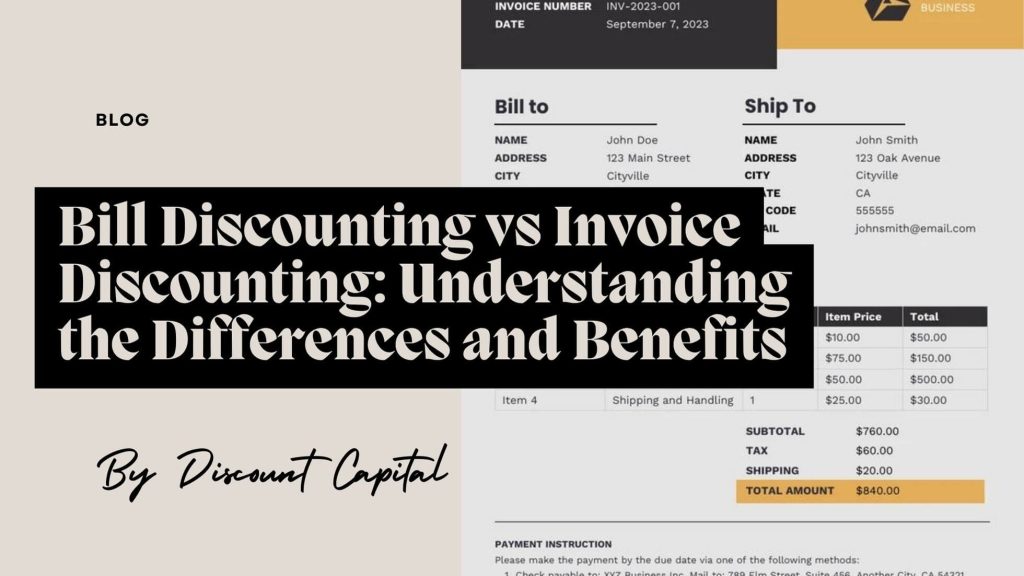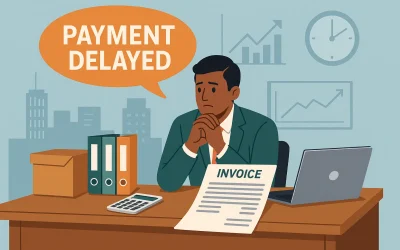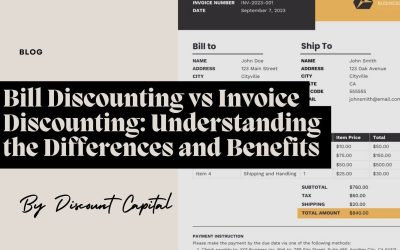Bill Discounting vs Invoice Discounting: Understanding the Differences and Benefits

In a world of business finance so dynamic, managing cash flow is crucial for maintaining operations and fueling growth. Two popular financing options that companies use to improve their cash flow are bill discounting in Kenya and invoice discounting in Kenya.
Although they share similarities, they cater to different financial needs and operate in distinct ways.
This article will delve into the intricacies of both bill discounting and invoice discounting, providing a detailed comparison and practical examples.
What is Bill Discounting in Kenya?
Bill discounting in Kenya is a financial arrangement where a business sells its trade bills (bills of exchange) to a financial institution at a discount to receive immediate cash. This financial tool is commonly used by businesses to bridge the gap between the sale of goods and receipt of payment.
Process of Bill Discounting
- Issuance of Bill: When a business sells goods or services, it issues a bill of exchange to the buyer. This bill serves as a promise that the buyer will pay the seller a specified amount at a future date.
- Discounting: The seller presents the bill of exchange to a financial institution (e.g., Discount Capital) before its maturity date. The financial institution purchases the bill at a discount, providing the seller with immediate funds.
- Maturity and Collection: On the bill’s maturity date, the financial institution collects the full amount from the buyer.
Example of Bill Discounting
Let’s consider an example where Twelvecity Digital Agency supplies custom folders worth KES 869,523 to Taxmart Kenya. Twelvecity issues a bill of exchange to Taxmart Kenya, payable in 90 days. Twelvecity needs immediate cash to manage its operations and decides to approach Discount Capital for bill discounting.
- Step 1: Twelvecity issues a bill of exchange to Taxmart Kenya for KES 869,523, payable in 90 days.
- Step 2: Twelvecity presents the bill to Discount Capital and sells it at a discount. If the discount rate is 5%, Discount Capital might provide Twelvecity with KES 826,046.85 (869,523 – (869,523 * 0.05)).
- Step 3: On the bill’s maturity date, Discount Capital collects KES 869,523 from Taxmart Kenya.
Key Features of Bill Discounting
- Type of Financial Instrument: Bills of exchange.
- Risk: The financial institution assumes the risk of default if the buyer fails to pay.
- Use: Suitable for short-term financing needs, typically used in trade and commerce.
What is Invoice Discounting?
Invoice discounting in Kenya is a financial arrangement where a business uses its accounts receivable (invoices) as collateral to obtain a loan or advance from a financial institution. Unlike bill discounting, the business retains control over its sales ledger and the collection of payments.
Process of Invoice Discounting
- Issuance of Invoice: When a business sells goods or services, it issues an invoice to the buyer, specifying the amount owed and the payment terms.
- Discounting: The seller presents the invoice to a financial institution (e.g., Discount Capital) and receives an advance on the invoice amount, typically a percentage of the total value.
- Repayment: The seller collects the payment from the buyer and repays the financial institution the advance amount plus a fee.
Example of Invoice Discounting
Continuing with the previous example, Twelvecity Digital Agency supplies custom folders worth KES 869,523 to Taxmart Kenya and issues an invoice with a 60-day payment term. To improve cash flow, Twelvecity decides to use invoice discounting through Discount Capital.
- Step 1: Twelvecity issues an invoice to Taxmart Kenya for KES 869,523, payable in 60 days.
- Step 2: Twelvecity presents the invoice to Discount Capital and receives an advance of 80% of the invoice value. Discount Capital provides Twelvecity with KES 695,618.40 (869,523 * 0.80).
- Step 3: After 60 days, Taxmart Kenya pays the invoice amount (KES 869,523) to Twelvecity. Twelvecity then repays Discount Capital the advance amount plus a fee, retaining the remaining balance.
Key Features of Invoice Discounting
- Type of Financial Instrument: Invoices (accounts receivable).
- Risk: The seller retains the risk of default if the buyer fails to pay.
- Confidentiality: Often confidential, meaning the buyer is unaware of the financing arrangement.
- Control: The seller retains control over the sales ledger and customer relationship.
Comparison of Bill Discounting and Invoice Discounting
Let’s compare these two on case by case.
Comparison Table: Bill Discounting in Kenya vs Invoice Discounting
| Feature | Bill Discounting | Invoice Discounting |
|---|---|---|
| Financial Instrument | Bills of exchange | Invoices (accounts receivable) |
| Ownership of Receivables | Transferred to the financial institution | Retained by the business |
| Risk of Default | Typically on the financial institution | Typically on the business |
| Confidentiality | Usually known to the buyer | Often confidential |
| Control over Sales Ledger | Transferred to the financial institution | Retained by the business |
| Purpose | Short-term financing | Improving cash flow |
| Payment Collection | By the financial institution | By the business |
1. Financial Instrument
- Bill Discounting: Involves bills of exchange.
- Invoice Discounting: Involves invoices (accounts receivable).
2. Ownership of Receivables
- Bill Discounting: The financial institution takes ownership of the receivable.
- Invoice Discounting: The business retains ownership of the receivable.
3. Risk of Default
- Bill Discounting: The financial institution assumes the risk of default.
- Invoice Discounting: The business retains the risk of default.
4. Confidentiality
- Bill Discounting: The buyer is aware of the arrangement.
- Invoice Discounting: The arrangement can be confidential, with the buyer unaware.
5. Control over Sales Ledger
- Bill Discounting: The financial institution may take control of the sales ledger.
- Invoice Discounting: The business retains control over the sales ledger.
6. Purpose
- Bill Discounting: Primarily used for short-term financing needs in trade and commerce.
- Invoice Discounting: Used to improve cash flow and manage working capital.
7. Payment Collection
- Bill Discounting: The financial institution collects the payment from the buyer.
- Invoice Discounting: The business collects the payment from the buyer.
Benefits of Bill Discounting and Invoice Discounting In Kenya
Now that the foundational differences between bill discounting in Kenya and invoice discounting in Kenya have been explained, let’s explore how your business can benefit from these two tools.
Benefits of Bill Discounting
- Immediate Cash Flow: Provides businesses with immediate funds to manage operations and expenses.
- Risk Mitigation: Transfers the risk of default to the financial institution.
- Creditworthiness: Enhances the business’s creditworthiness by converting receivables into cash.
- Simple Process: Straightforward process involving the discounting of a bill of exchange.
Benefits of Invoice Discounting
- Improved Cash Flow: Provides businesses with immediate funds to maintain liquidity and manage working capital.
- Confidentiality: Can be a confidential arrangement, keeping the financing process discreet.
- Control: Retains control over the sales ledger and customer relationships.
- Flexible Financing: Offers flexible financing options based on the value of invoices.
Practical Application: Discount Capital and Twelvecity Digital Agency
Let’s consider the scenario below to illustrate the differences between these two financial process.
Scenario: Twelvecity Digital Agency Supplies Custom Folders to Taxmart Kenya
- Amount: KES 869,523
- Financier: Discount Capital
- Service Needed: Immediate cash flow for operations
Bill Discounting Process
- Issuance of Bill: Twelvecity issues a bill of exchange to Taxmart Kenya, payable in 90 days.
- Discounting: Twelvecity presents the bill to Discount Capital and receives KES 826,046.85 after a 5% discount.
- Collection: On the bill’s maturity date, Discount Capital collects KES 869,523 from Taxmart Kenya.
Invoice Discounting Process
- Issuance of Invoice: Twelvecity issues an invoice to Taxmart Kenya for KES 869,523, payable in 60 days.
- Discounting: Twelvecity presents the invoice to Discount Capital and receives an 80% advance of KES 695,618.40.
- Repayment: After 60 days, Twelvecity collects KES 869,523 from Taxmart Kenya and repays Discount Capital the advance plus a fee.
Need urgent cashflow? Consider bill discounting or invoice discounting from Discount Capital Ltd
Both bill discounting and invoice discounting are valuable financial tools for businesses looking to improve cash flow and manage working capital.
While bill discounting involves the sale of bills of exchange and transfers the risk of default to the financial institution, invoice discounting uses accounts receivable as collateral and retains the risk with the business.
Each method has its unique advantages and is suited to different business needs and circumstances.
By understanding the differences and benefits of bill discounting and invoice discounting, businesses can make informed decisions to optimize their financial strategies and ensure smooth operations.
Whether it’s through the immediate cash flow provided by bill discounting or the flexible financing of invoice discounting, these tools can significantly enhance a company’s financial health and growth prospects.
Reach out to us or start by evaluating your funding readiness using our simple tool here.



